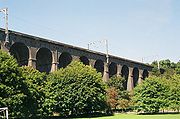
Welwyn Viaduct
Encyclopedia

East Coast Main Line
The East Coast Main Line is a long electrified high-speed railway link between London, Peterborough, Doncaster, Wakefield, Leeds, York, Darlington, Newcastle and Edinburgh...
over the River Mimram
River Mimram
The Mimram Valley is named after the River Mimram, which rises from a spring to the north of Whitwell, in North Hertfordshire, England, and makes its confluence with the River Lea near Horn's Mill in Hertford. At Whitwell there are cress beds which have existed since Roman times and these are fed...
and a locally important landmark. It is located between Welwyn Garden City
Welwyn Garden City
-Economy:Ever since its inception as garden city, Welwyn Garden City has attracted a strong commercial base with several designated employment areas. Among the companies trading in the town are:*Air Link Systems*Baxter*British Lead Mills*Carl Zeiss...
and Digswell
Digswell
Digswell is an ancient village in the English county of Hertfordshire which is recorded in the 1086 Domesday Book.Digswell's name may be derived from Deacon's Well. There were two Manors, with 2 water Mills, much land under plough, and a large area of woodland...
. It is just to the south of Welwyn North railway station
Welwyn North railway station
Welwyn North railway station serves the villages of Digswell and Welwyn in Hertfordshire, England. The station is located approximately north of London Kings Cross, on the East Coast Main Line.-Location:...
.
The viaduct is around 1560 feet (475 m) long and comprises forty arches of 30 ft (9 m) span, and is 100 ft (30 m) high from ground level to trackbed. It is built of brick fired from brick clay quarried on site during construction, and took two years to build, including the construction of embankments at both ends which required the movement of around one million tons of earth by human and horse power. It was designed by William Cubitt
William Cubitt
Sir William Cubitt was an eminent English civil engineer and millwright. Born in Norfolk, England, he was employed in many of the great engineering undertakings of his time. He invented a type of windmill sail and the prison treadwheel, and was employed as chief engineer, at Ransomes of Ipswich,...
and styled after a Roman aqueduct
Aqueduct
An aqueduct is a water supply or navigable channel constructed to convey water. In modern engineering, the term is used for any system of pipes, ditches, canals, tunnels, and other structures used for this purpose....
.
It was originally opened by Queen Victoria on 6 August 1850, but she was so frightened of its height that she refused to travel across it. The train carrying her had to stop, upon which she left the train and entered a horse drawn carriage to travel the length of the bridge on the ground. She then re-entered the train at the other end of the viaduct and continued her journey. It carries the East Coast Main Line
East Coast Main Line
The East Coast Main Line is a long electrified high-speed railway link between London, Peterborough, Doncaster, Wakefield, Leeds, York, Darlington, Newcastle and Edinburgh...
, which has to narrow from four tracks to two to cross the viaduct, making it a bottleneck restraining capacity over this strategic transport route. This problem is exacerbated by Welwyn North railway station
Welwyn North railway station
Welwyn North railway station serves the villages of Digswell and Welwyn in Hertfordshire, England. The station is located approximately north of London Kings Cross, on the East Coast Main Line.-Location:...
situated at the northern end of the viaduct, which blocks the line while trains are stationary. Several ideas to overcome the limitations of the viaduct and station without damaging the viaduct's essential historic character and rhythmic design are periodically discussed. The line was electrified in the 1970s.

